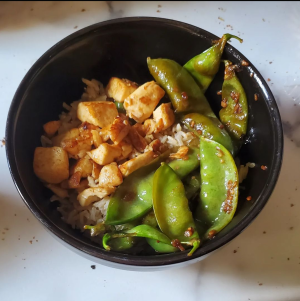When it’s the middle of your work week and the crisper draw is reduced to an odd assortment of vegetables with seemingly no correlation to a dish in your brain bank of recipes, it can feel nearly impossible to come up with a tasty, veggie-inclusive meal. No need to let this dinner dilemma derail your night! Such an occasion is an excellent opportunity for a stir-fry. Chinese in origin, stir-frying is a cooking method where produce and protein are swiftly fried in oil and sauce, typically using a wok. The resulting dish preserves some of the crisp, freshness of the veggies while highlighting the delicious flavors that come with the addition of a well-balanced stir-fry sauce. With the right veggie prep and sauce composition, this meal could very well be the best one you make this week! This stir-fry guide will cover veggie tips, sauce ideas, and stir-fry suggestions that are sure to save you from what could otherwise be an unappetizing medley of underflavored vegetables.
Veggie Tips for an Outstanding Stir-Fry
Do Right by Your Greens
Leafy greens, like spinach, kale, and bok choy, make a great addition to stir-frys! However, greens can have some unexpected setbacks if they aren’t prep correctly or added to your stir-fry at the optimal time. Here are some general tips on how to treat your greens so that they shine in your stir-fry:
- Be sure to separate your leaves and stems before adding them to heat! The hearty stems of leafy greens typically cook at a different rate than the tender leaves, so it is important to remove the stems before adding them to heat so your leaves don’t overcook.
- Be mindful of the cook-down effect! Greens normally cook down significantly, reducing by almost half or more of their size when raw. Be sure to add more greens than you think you need to if you want them to be a substantial element to your stir-fry.
- Adjust your cook time based on the thickness of your greens. Greens come in a variety of densities, some are delicate, like spinach or beet greens, whereas others are hearty, such as collard greens or kale. The thicker the green the longer they will need to cook so that they become tender and delicious.
Add Some Aromatics
Aromatics are herbs and vegetables that create distinct scents (or aromas) when heated or crushed. Aromatics may sound fancy, but nearly anyone who cooks has used an aromatic before. Vegetables like onions, garlic, ginger, and jalapeños are just a few examples of aromatics. Try briefly frying your aromatics in oil before adding your veggies to help enhance the overall taste of your meal.
Avoid the Mush
Help your veggies maintain their crisp, fresh texture by stir-frying in a pan that isn’t overcrowded. Most vegetables have high water content and will release this moisture when exposed to heat. A pan that is jam-packed with cooking vegetables will often boil rather than fry due to excessive liquid. Avoid a mushy stir-fry by frying only a couple of vegetables at a time or by cooking your vegetables in batches.
Composing a Well-Balanced Stir Fry Sauce and General Rules
While nicely cooking your veggies can add depth to the taste of your stir-fry, the sauce you use is foundational in creating a flavorful dish. It can be tempting to grab a pre-made stir-fry sauce (and sometimes necessary), but making your own sauce gives you better control of the flavor and is often a healthier option. Plus, stir-fry sauce is relatively simple to make. The fundamental components of a well-balanced stir-fry sauce include soy sauce, something acidic, a sweetener, and a thickener. Typically, it is equal parts sweetener and acidic ingredients followed by 3 times the amount of soy sauce and a teaspoon or so of thickener. However, the quantity of each should be determined by your flavor preferences and the portion of food you are preparing. Below are some suggested ingredients that you can include in your next stir-fry sauce:
Soy Sauce Alternatives
- Tamari
- Coconut amino
- Fish sauce
- Worcestershire sauce
- Miso paste
- Oyster Sauce
Sweeteners
- Maple syrup
- Honey
- Brown sugar
- White sugar
Acidic Ingredients
- Rice Vinegar
- White Vinegar
- Apple cider vinegar
- Pickling brine
Thickeners
- All-purpose flour
- cornstarch
- Arrowroot powder
- Rice flour
Spicy Additions to Consider
- Minced spicy pepper
- Dried red pepper flakes
- Pre-made spicy sauce of your choice (sriracha!)
Although soy sauce, sweetener, something acidic, and thickener are the basic elements of a stir-fry sauce, don’t be afraid to add some other flavor-enhancing ingredients to your sauce! Once you have decided on your sauce ingredients, assemble your stir-fry sauce in a bowl or jar and mix until well incorporated. Be sure to add your sauce once the whole meal is about complete, and cook for an additional 3-5 minutes.
Experiment and Get Inspired
The more often you cook stir-fries, the more familiar you will get with what your taste buds love. Don’t be afraid to try different arrangements of sauce ingredients or test out different veggie combinations. Sharing your recipe is also a great way to improve your stir-fry game. Your local Fresh Stop volunteers and fellow shareholders are sure to have great stir-fry suggestions. Above are a few fantastic stir-fries submitted to our Seed to Supper Challenge! Use them as a jumping-off point to get started on your own delicious stir-fry creation.



